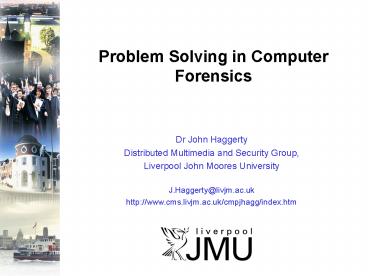Problem Solving in Computer Forensics - PowerPoint PPT Presentation
1 / 15
Title:
Problem Solving in Computer Forensics
Description:
'What would you take' tutorial computer forensics in law enforcement. At the 'light' ... 'Network diagrams' tutorial computer forensics beyond law enforcement ... – PowerPoint PPT presentation
Number of Views:63
Avg rating:3.0/5.0
Title: Problem Solving in Computer Forensics
1
Problem Solving in Computer Forensics
Dr John Haggerty Distributed Multimedia and
Security Group, Liverpool John Moores
University J.Haggerty_at_livjm.ac.uk http//www.cms.
livjm.ac.uk/cmpjhagg/index.htm
2
Outline of talk
- Introduction to Liverpool JMU
- Module background
- My philosophy
- Problems I have encountered
- My teaching approach
- Some examples
- Findings and conclusion
3
Background to JMU
- Lecturer in Computer Security and Forensic
Computing - Computer security background
- Academic research
- Practical experience
- Liverpool JMU reputation in computer security
research (Distributed Multimedia and Security
Group) - Requirement for wider knowledge of security and
forensic issues
4
Module background
- Run first time 2004/2005
- Initial expectation to complement mainstream
Forensics programme at JMU - Different levels of expectation and ability
- Forensic Computing
- BSc (level 3)
- Approx. 50 students (up from approx. 40
2004/2005) - IS, MMS, CS and SE options (2005/2006 extended to
MMS)
5
Module aims and objectives
- Forensic Computing
- Aims
- To develop an understanding of the theory and
practice of computer forensics. - Objectives
- Understand the fundamental technical concepts,
implementation, and restrictions of computer
forensics in the organisation. - Analyse and evaluate physical and data evidence
in computer forensics. - Develop practical skills in computer forensics.
6
My Forensic Computing philosophy
- Relationship between computer security and
computer forensics related but distinct - Same tools but different outcomes
- Computer forensics beyond the legal arena
- Application of tools and techniques within other
areas - e.g. businesses, public sector organisations,
national security, etc.
7
Problems I have found
- Computer forensics as art not science
- Trying to teach analysis
- Students from across the computing spectrum
- University policies and no dedicated lab space
- No control over machines within university
- Not able to put own software on machines
- Not able to use computer forensics programs
- Creativity required to adhere to restrictions
whilst at the same time providing practical
learning experience for students - Countering student fantasies
- Forensic Computing its just like CSI
8
Three strands of teaching
- Three strands of teaching used on the course
- Principles of forensic computing
- Focus on academic issues
- Traditional lecture format (summative)
- Guest lectures
- Marry what students have learnt with practitioner
experience - Practical applications of forensic computing
- Marrying academic issues to practical issues
(formative) - Tutorial-based format using PBL
- Coursework providing practical experience through
PBL
9
Teaching practical applications
- A challenging problem as university network
administrators are nervous about teaching
forensics applications - Security incidents
- More interesting for the lecturer!
- Practical teaching required
- As laid out in proforma set by PPA
- To reinforce theoretical learning
- Approached in two ways
- Tutorial-based PBL
- Coursework PBL
10
Tutorial-based PBL example 1
- What would you take tutorial computer
forensics in law enforcement - At the light end of PBL
- Present students with a real-world problem based
on the subject matter discussed during the lecture
11
Tutorial-based PBL example 2
- Network diagrams tutorial computer forensics
beyond law enforcement - Used by organisations, national security, etc.
- Technique used in network security to track
network connections and hosts - Useful as analytical exercise
12
Teaching practical forensics
- Students not allowed to forensically analyse
university computers - Encourage use of forensic Knoppix distros on home
machines - Partnership with Guidance Software and their
EnCase suite - Limited version disk used to allow students to
gain hands on experience with industrial standard
software - Runs from CD only
- Tutorial cases
- Additional relevant white papers
13
PBL-based Coursework
- Combine theoretical/practical student experience
- Build on practical labs
- Use of tools for file analysis
- Understanding of wider tools
- Restricted use/built (Knoppix) distros
- Gives students opportunity to write own job
description for forensic computing within an
organisation - (Hopefully) brings course together!
14
Findings and recommendations
- Student comments having undertaken the forensic
computing module have provided extremely positive
responses - Felt they have learned a real skill (PBL)
- The level of engagement in lectures was high
- Deeper level of understanding analytical
toolkit - Invest the time in exploring tools that can be
used - Guest lectures enhance learning experience
- Bridge gap between academic subject and its
practical application - Use techniques that demonstrate the idea or
concept
15
Summary
- Computer forensics is increasingly used beyond
the legal arena - A number of problems have been encountered which
have affected my approach - A mix of practical and theoretical learning via
problem setting does work - The practical does not necessarily require
unpleasant/ unwanted access - For me, it has been a positive experience!































